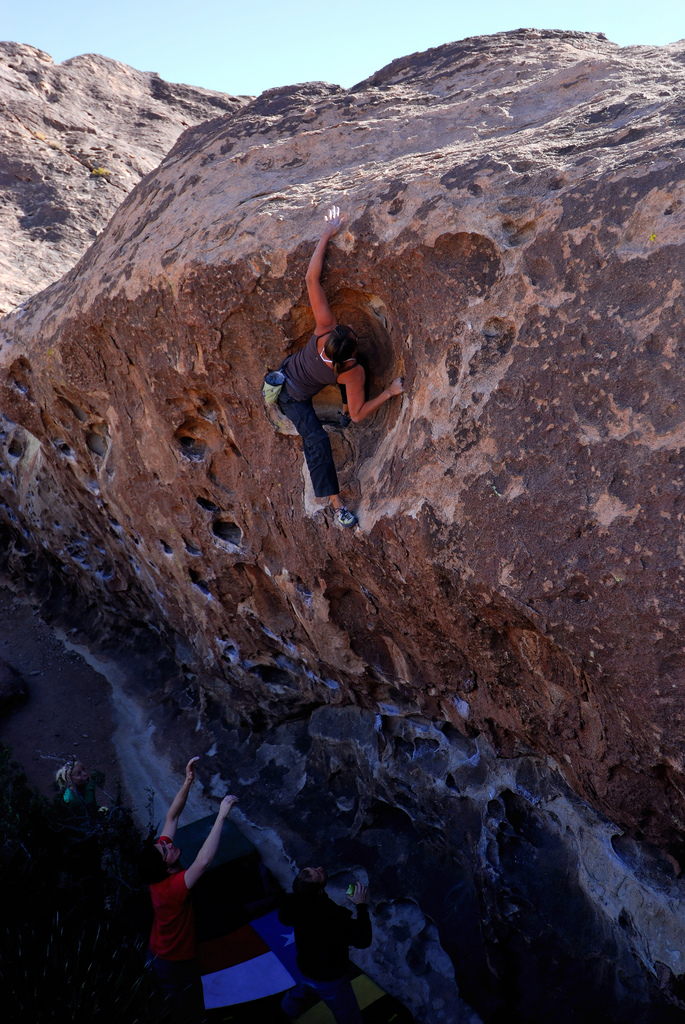The Uncertain Future of Hueco Tanks, Texas’ Bouldering Mecca
NULL

The following is a a guest post by Ann Raber, an Observer friend, KPFT contributor, and rock-climbing aficionado. Raber runs SendAustin, a popular Central Texas rock-climbing blog.
There’s nothing hyperbolic about calling Hueco Tanks State Park and Historic Site a North American bouldering mecca.
For this particular kind of rock climber, who shirks ropes and heights in favor of portable foam crash pads and difficult moves made low to the ground, there is nowhere better. Okay there’s maybe one place, but it’s in France and it’s not exactly better, just comparable.
And there is a potentially better one in South Africa, but that is just so far away. Hueco’s unique formations are mimicked in plywood and plastic at climbing gyms around the world, and the difficulty scale for these low-ball, physically powerful climbs (V0 to V15) was developed there in the 1980s.
But the fragile ecology and archaeological significance of the park have restricted climber access to guided tours unheard of in other popular climbing areas. Add to that the issue of funding for state parks that has threatened a management transfer of Hueco Tanks, and our days with Hueco could be numbered.
 Climbing season in Texas will start in November. Climbers who have purchased land on the road to the park will be rolling out their trailers in the fall, and by Thanksgiving they’ll dominate the 860-acre park, mainly on guided tours according to the rules established in the 1998 Public Use Plan.The PUP was an effort to control vandalism and environmental damage when far-flung climbers started making the trip for world class winter bouldering. It restricted access to 2/3rds of the park to guided tours of limited size and mobility, was a response to a sudden increase in visitors.
Climbing season in Texas will start in November. Climbers who have purchased land on the road to the park will be rolling out their trailers in the fall, and by Thanksgiving they’ll dominate the 860-acre park, mainly on guided tours according to the rules established in the 1998 Public Use Plan.The PUP was an effort to control vandalism and environmental damage when far-flung climbers started making the trip for world class winter bouldering. It restricted access to 2/3rds of the park to guided tours of limited size and mobility, was a response to a sudden increase in visitors.
John Sherman, whose name beget the V-scale (“V” for “Vermin,” rhymes with “Sherman,” it was a nickname, long story), explored Hueco Tanks in the 1980s, and penned the first climbing guidebook to the area.
He offered a point by point refutation of the plan, which is still in effect in essentially the same form. Sherman argued that the bulk of the ecological and archaeological damage done to the site was not cause by climbers, yet they bore the brunt of the restrictions.
Many of the newly proposed restrictions are designed to restrict and discourage climbing at HTSP. I feel this is a shame. Climbers are people too, just like rangers, bird watchers, and archaeologists. Discriminating against them is unfair. Furthermore, they generate more revenue for HTSP that any other user group…. I believe climbers can be one of the strongest allies HTSP can have.
Since then, even as climbers have adhered mightily to the rules, access to climbing at Hueco has continued to erode. In 2007 Hueco made the list of historic sights to be transfered from TPWD to the Texas Historical Commission.
Climbers have worked hard to get into the margins of the good graces of park officials, and there is not much hope that the THC would be as accommodating.
According to the Access Fund, which offers professional support and funding to “open and conserve the climbing environment”, climbers have reason fear the THC taking over Hueco. They cite the commissions “museum approach” to site management could change our access to those stout boulders.
“When the budget for Texas climbing parks suffers your climbing future is at risk.” But it isn’t just the Lege or the historical commission that threaten climber access. It happens every season or two with small sections of the park being axed.
Sections of the park are closed to climbing and/or foot traffic, including some beloved hunks of stone. In December, 2007 the Mushroom boulder, in the self-guided area of the park, was closed to rock climbing due to archeological damage. The department said that they didn’t intend to “place blame on climbers.”
Still, the department said that the damage “was found in the area where foot traffic and crash pad placement were concentrated, due to the overhang’s popularity as a bouldering area.” The climbing community took the loss pretty hard. Steve Crye, who runs a quirky Hueco Tanks news site, said at the time:
I’ve been so disgusted with the idiotic closure of the north side of Mushroom boulder that I could not even motivate myself to update the huectanks.com website, much less go and shoot photos of the moronic “Closed to all recreational activity” signs. Sometime in the next month I’ll grit my teeth and drive out there, perhaps for the last time.
The 81st legislative session was silent on the issue of transferring, and there were no painful closures in 2008/2009 season, so it’s with optimism and reservations made far in advance that boulderers will carry on this winter, getting it while we can. (pic by chris tsay)


